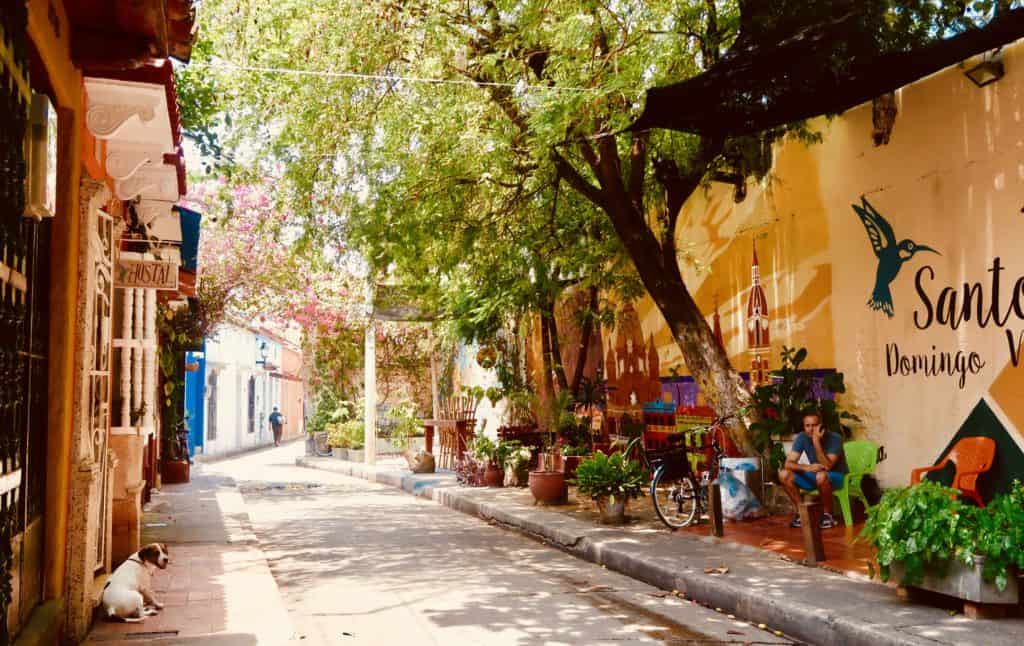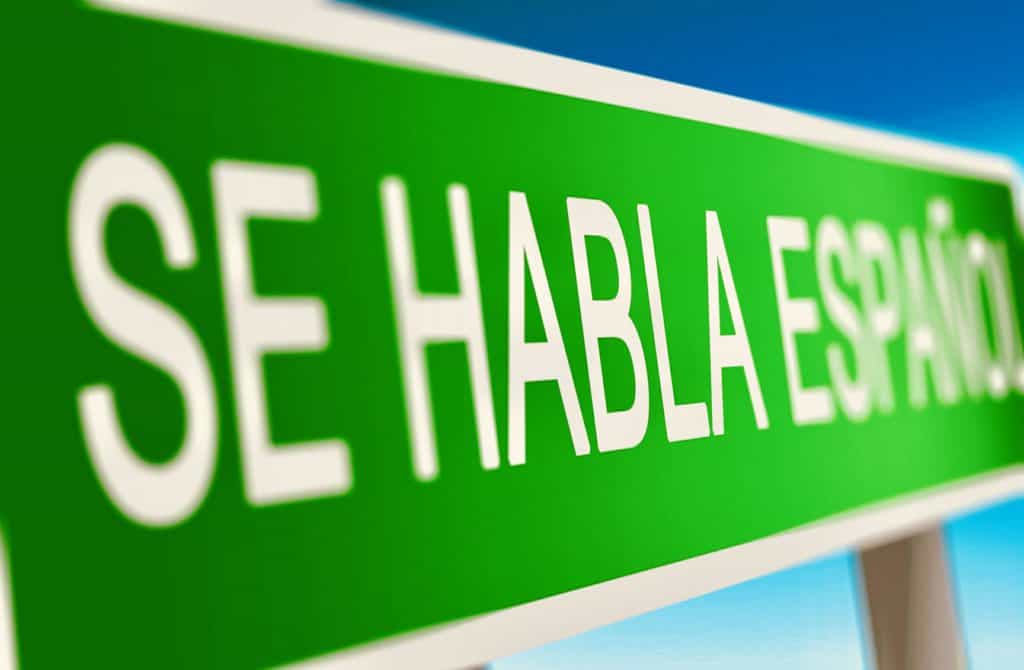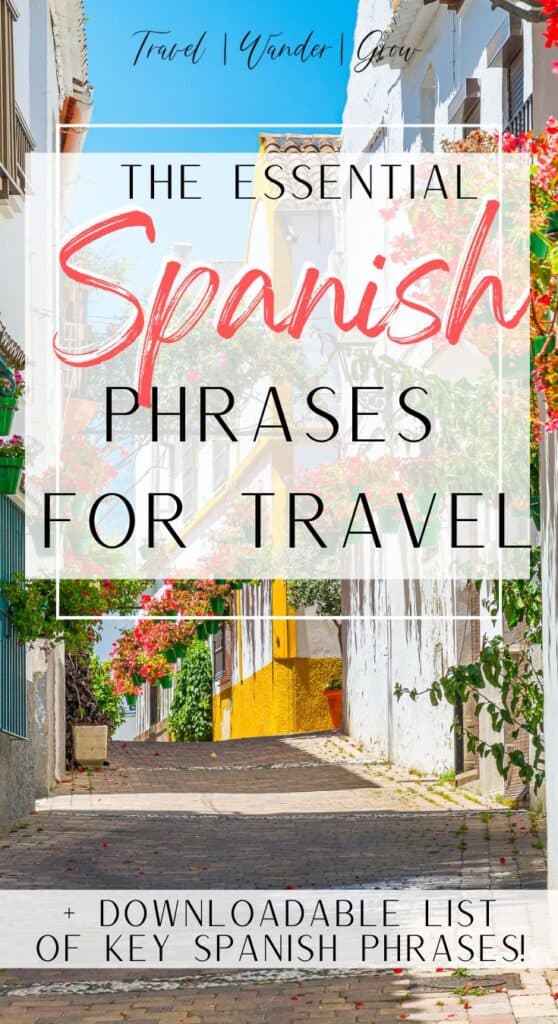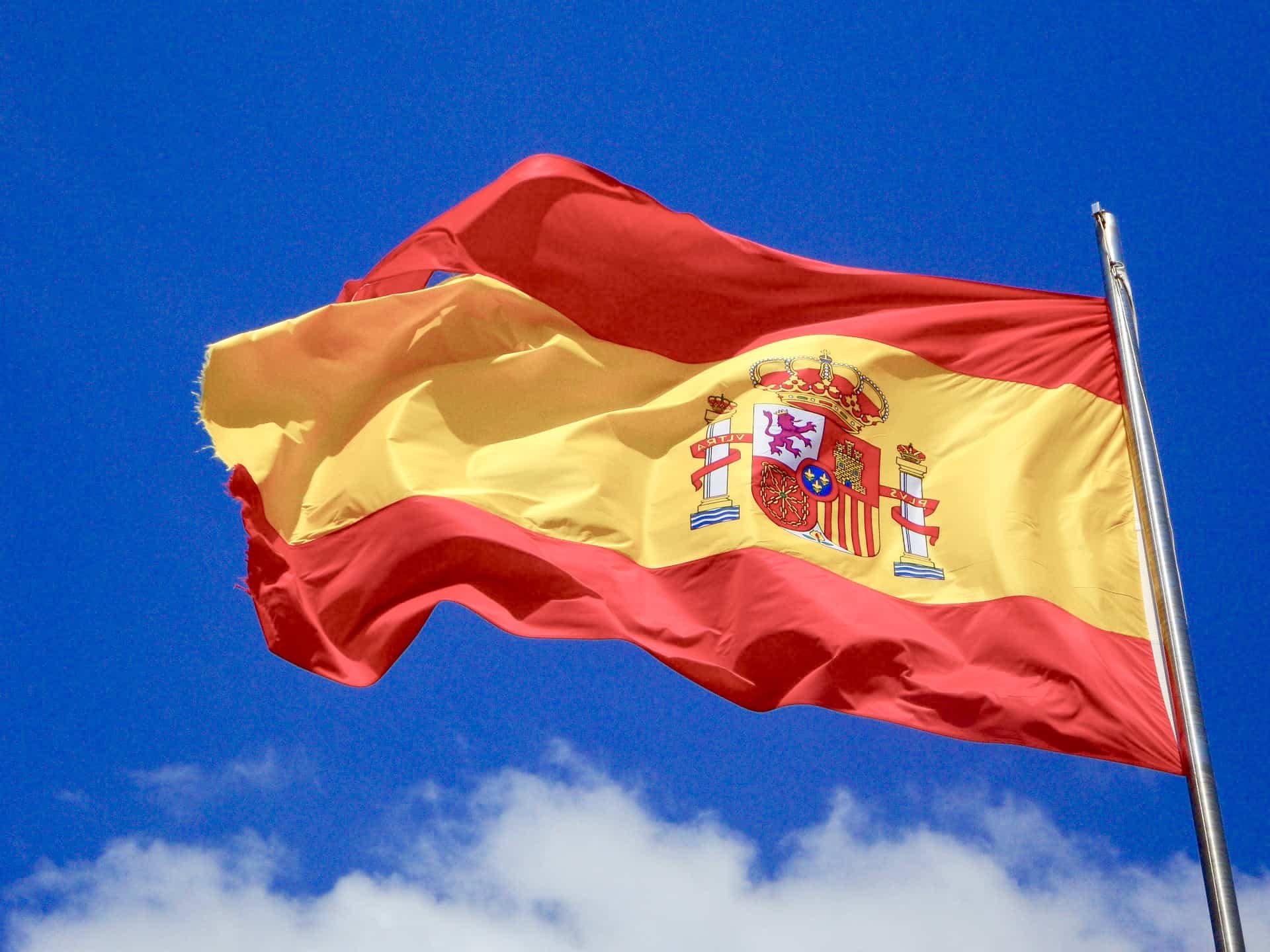The Essential Spanish Phrases for Travel PDF
As I mentioned in my post on the benefits of foreign language for travel, I think that learning the basics of the language to any country you visit is a great way to bettter experience the local culture. If you’ve read my post on Sagunto, you may know that I studied abroad there and speak it at about an intermediate (B2) level. I love this language, and seeing it’s popularity, I am glad that I spent time learning it.
As there are many countries around the world where Spanish is the primary language, it is pretty likely that you’ll hit one of these countries on your travels. This post will cover the basics of Spanish phrases for travel, which you can use as your pocket guide while traveling to any Spanish-speaking country!
Spanish Language Overview
Spanish is the second most spoken language in the world, after Mandarin! There are 442 million speakers of Spanish around the globe, and it is the official languages of 21 countries across Europe, Africa, and the Americas. These specific countries and territories include:
- Colombia
- Costa Rica
- Cuba
- Guatemala
- Mexico
- Peru
- Puerto Rico
- Spain
It is a Romance language, meaning it comes from Latin. That means that learning Spanish will certainly help you with learning the other Romance languages. Particular in the areas of grammar and root words.

get your free download!
Spanish Phrases PDF
This free download includes all the key Spanish phrases that you will need for your travels throughout Spain, Mexico and any Spanish-speaking country. In addition, get details on the best resources to improve your speaking and listening skills as well.
History of the Spanish Language
The history of the Spanish language is shaped by centuries of cultural, political, and linguistic influences. Its roots can be traced back to the Roman Empire, when Latin was introduced to the Iberian Peninsula around the 3rd century BCE. Over time, Latin evolved into various dialects, blending with local languages spoken by native Iberian populations. However, it was during the medieval period, particularly after the Moorish conquest of Spain, that the foundations of modern Spanish began to take shape.
The influence of Arabic and other languages spoken by the Moors infused the evolving Romance dialects with new vocabulary, grammar, and pronunciation. The gradual reconquest of Spain by Christian kingdoms led to the unification of the language, and by the 13th century, a standardized version of Spanish, known as Castilian, emerged as the dominant dialect. With the colonization of the Americas by the Spanish, the language spread across the globe, becoming one of the world’s most widely spoken languages.

Spanish Pronunciation Tips
Spanish pronunciation can be a delightful challenge for language learners, but with a few key tips, mastering the sounds becomes more attainable:
- One important aspect is understanding that Spanish has a consistent sound-to-letter correspondence, meaning letters are usually pronounced the same way regardless of their position in a word. It is also crucial to pay attention to vowel sounds, as they are clear and distinct in Spanish. Mastering the five vowel sounds, namely “a,” “e,” “i,” “o,” and “u,” will greatly enhance pronunciation accuracy.
- Another tip is to focus on correctly pronouncing the rolled “r” sound, which is a unique feature of Spanish. Practicing tongue trills or tapping the tongue against the roof of the mouth can help achieve this sound.
- Additionally, being aware of syllable stress is crucial since Spanish is a syllable-timed language. Recognizing which syllables are stressed can improve both comprehension and fluency.
- Finally, listening to native Spanish speakers and immersing oneself in Spanish language media can greatly aid in developing an authentic and natural pronunciation.
Your Spanish Phrases for Travel Cheatsheet
Spanish Greetings
Below are basic Spanish greetings you’d use to greet or say goodbye to locals:
- Hello – Hola
- Hello/Goodbye – Chao
- How are you? – ¿Cómo estás?
- Good morning – Buenos días
- Good afternoon – Buenas tardes
- Good night / Good evening – Buenas noches
- Goodbye – Adiós
- What is your name? – ¿Cómo te llamas? / ¿Cómo se llama? (formal)
- My name is… – Me llamo…
- My name is… – Mi nombre es (less commonly used)
- Nice to meet you – Mucho gusto / Encantado(a) a conocerle
- Have a great day! – ¡Que tengas un buen dia!
- See you later – Hasta luego
- How are you? – ¿Como estás?
- What’s up? – Qué pasa?
- Very well – Muy bien
- I’m fine – Estoy bien
- Okay / So-so – Más o menos
- And you? – ¿y tú?
Essential Phrases
Essential phrases are those you’d use most frequently, outside of greetings of course.
- Yes – Sí
- No – No
- Thank you – Gracias
- Thanks a lot – Muchas gracias
- You’re welcome – De Nada
- Excuse me – Perdón / Disculpe / Permiso / Con permiso
- I’m sorry – Lo siento
- Do you speak English? – ¿Hablas inlgés?
- I don’t speak English – No hablo inglés
- I don’t understand – No entiendo
- Please – Por favor
- Slowly – Despacio
- Repeat – Repita
- Where is the bathroom? – ¿Dónde está el baño?

Days, Months, and Time
The days of the week and all other phrases related to telling time.
Days/Week
- Day – Día
- Week – Semana
- Sunday – Domingo
- Monday – Lunes
- Tuesday – Martes
- Wednesday – Miércoles
- Thursday – Jueves
- Friday – Viernes
- Saturday – Sábado
Months/Year
- Month – Mes
- Year – Año
- January – enero
- February – febrero
- March – marzo
- April – abril
- May – mayo
- June – junio
- July – julio
- August – agosto
- September – septiembre
- October – octubre
- November – noviembre
- December – deciembre
Telling Time
- Minute – Minuto
- Hour – Hora
- Time – Hora / Tiempo
- What time is it? – ¿Qué hora es?
- It is 1:00 – Es la una
- It is 2:00 / 3:00 – Son las dos / tres
- What day is today? – ¿Qué día es hoy?
- Tomorrow – Mañana
- Yesterday – Ayer
- Morning – Mañana
- Midday – Mediodía
- Midnight – Medianoche
- Night – Noche
- (Three weeks) ago – Hace (tres semanas)
- Today – Hoy
- Now – Ahora
Numbers
| One – Uno / Una | Sixteen – Dieciséis |
| Two – Dos | Seventeen – Diecisiete |
| Three – Tres | Eighteen – Dieciocho |
| Four – Cuatro | Ninteen – Diecenueve |
| Five – Cinco | Twenty – Veinte |
| Six – Seis | Twenty-one – Veintiuno |
| Seven – Siete | Thirty – Trienta |
| Eight – Ocho | Forty – Cuarenta |
| Nine – Nueve | Fifty – Cincuenta |
| Ten – Diez | Sixty – Sesenta |
| Eleven – Once | Seventy – Setenta |
| Twelve – Doce | Eighty – Ochenta |
| Thirteen – Trece | Ninety – Noventa |
| Fourteen – Catorce | One Hundred – Cien |
| Fifteen – Quince | One Hundred and One – Ciento uno |
Directions
Phrases and words for getting around town.
- Where is…? – Dónde está…
- The bus stop – La parada de autobús
- The bank – El banco
- The museum – El museo
- The park – El parque
- The hospital – El hospital
- The airport – El aeropuerto
- The church – La iglesia
- How do you get to…? – ¿Cómo se va a…?
- Left – Izquierda
- Right – Derecha
- Straight – Derecho
- Turn to the... – Gira a la…
- How far away is…? – ¿Qué tan lejos está…?
- It is two blocks away – Está a dos manzanas.
- It is five minutes away – Está a cinco minutos.
- What is the address? – Cuál es la direccion?
Transportation
Phrases and words for traveling to further destinations.
- By bus – En autobús
- By train – En tren
- By car – En coche / en carro
- By plane – En avión
- By subway / metro – En metro
- Where is the train station? – ¿Dónde está la estación de tren?
- Where is the bus stop? – ¿Dónde está la parada de autobús?
Eating Out
Phrases and words to use when ordering food at a restaurant.
- Restaurant – El restaurante
- Breakfast – El desayuno
- Lunch – El almuerzo
- Dinner – La cena
- Appetizer – Entrada
- Main Course – Plato principal
- Desert – Postre
- What do you recommend? – ¿Qué nos recomienda?
- I would like (to order) – Querría…
- The bill please – La cuenta por favor
- I’m vegetarian – Soy vegetariano/a
- I’m allergic – Soy alérgica
- Red wine – Vino tinto
- White wine – Vino blanco

Shopping
Phrases and words to use when out shopping.
- How much does it cost? – ¿Cuánto cuesta?
- Store – La tienda
- Price – El precio
- Money – El dinero
- Credit card – Tarjeta de crédito
- Do you accept credit cards? – Se acepta tarjetas de crédito?
- Cash – Dinero en efectivo
- Discount – El descuento
- Shirt – La camisa
- Blouse – La blusa
- Pants – Los pantalones
- Shoes – Los zapatos
- Suit – El traje
- Swimsuit – El traje de baño
Regional Spanish Differences
From Latin America to Spain, Spanish does remain intelligible, but there are some particularities that may be useful to know:
Spain Spanish
One of the most prominent differences lies in the pronunciation and accent. In Spain, the Spanish accent tends to be more sibilant and has a softer, lisping quality, particularly in regions like Andalusia. Latin American Spanish, on the other hand, often features a clearer pronunciation of consonants and is generally considered to have a more melodious cadence.
Vocabulary is another area where variations can be observed. While the core vocabulary remains largely the same, there are differences in terms of certain words and expressions used in Spain versus Latin America. For instance, words related to everyday objects, food, and slang can vary between the two regions. Moreover, grammatical variations exist as well. In particular, the “plural you” used in Spain is vosotros, instead of usted like it is in most of Latin America.
Rioplatense Spanish
Also known as River Plate Spanish, this term refers to the distinct variety of Spanish spoken in the areas surrounding the Río de la Plata region, which includes Argentina and Uruguay. This variant of Spanish exhibits several particularities that set it apart from other Spanish dialects. One notable feature is the pronunciation, characterized by a unique intonation and rhythm.
Rioplatense Spanish has a strong Italian influence, reflecting the significant Italian immigration to the region in the late 19th and early 20th centuries. As a result, speakers often pronounce “ll” and “y” as a “zh” sound, known as “yeísmo” or “sh” sound, which is distinct from the “y” sound in standard Spanish.
Additionally, the Rioplatense dialect includes a variety of local idioms, slang, and vocabulary that differ from other Spanish-speaking regions. Words borrowed from Italian, known as “lunfardo,” are prevalent in the dialect and contribute to its distinctive flavor.
Cuban Spanish
Also known as “Cubano” or “Cubanismo,” this dialect possesses a distinct set of particularities that make it stand out within the Spanish-speaking world. One notable feature of Cuban Spanish is its pronunciation. The “s” sound at the end of words and syllables is often softened or omitted, a phenomenon known as “seseo.”
Additionally, the “r” sound is often rolled or trilled more prominently, giving Cuban Spanish a melodic and vibrant quality. Another characteristic of Cuban Spanish is the frequent use of augmentatives and diminutives to convey emphasis or affection. These suffixes, such as “-ito” and “-ote,” are commonly added to nouns and adjectives.
Cuban Spanish also showcases a rich vocabulary influenced by Afro-Cuban, Caribbean, and African linguistic elements, along with borrowings from English and French. Furthermore, the dialect features distinctive idiomatic expressions, humor, and wordplay that reflect the unique cultural identity and wit of the Cuban people.
Mexican Spanish
This variety of Spanish is what is most often taught in the US, and is also known as “español mexicano” or “mexicanismo”. One notable feature of Mexican Spanish is its pronunciation. It is characterized by a softening or elision of certain consonants at the end of words, such as the “s” sound, a phenomenon known as “seseo” (like Cuba).
Another distinctive aspect is the pronunciation of the “x” sound, which is often pronounced as an “h” sound. Mexican Spanish also includes a vast array of unique vocabulary, idiomatic expressions, and regional slang, known as “mexicanismos.” These linguistic elements are deeply rooted in the country’s history, indigenous cultures, and influences from Nahuatl, the Aztec language, as well as other indigenous languages.
Moreover, Mexican Spanish has borrowed extensively from English, particularly in the realm of technology and popular culture.
Practicing Spanish
Here is a youtube video (and channel) that will be useful for practicing your Spanish:
The Spanish Travel Phrases PDF
Download this PDF so that you can have all the key Spanish phrases at your fingerprints. Practice will make you more confident, so here is your chance to start learning more now!

get your free download!
Spanish Phrases PDF
This free download includes all the key Spanish phrases that you will need for your travels throughout Spain, Mexico and any Spanish-speaking country. In addition, get details on the best resources to improve your speaking and listening skills as well.
Spanish Phrases for Travel | Final Thoughts….
That completes my list of the basic Spanish phrases for travel! I hope that this list serves as a useful guide when you venture out to any of the 21 countries where Spanish is the official language! To get the most out of this list, you should practice often before taking your trip.
Even better than just using this list is practicing your new vocabulary with a real person! If this interests you, check out my favorite language resource, iTalki. You can use this site to practice with a tutor, formal teacher, or others just seeking to do a language exchange (for free!). The paid lessons have very cheap options, with some as low as $5 an hour. Check it out!
Travel Guides for Spanish Speaking Countries:
- Barcelona in Four Days
- Two Days in Granada
- One Day in Málaga
- What to Do in Cartagena, Colombia
- Lima Travel Guide
- What to do in Cusco
- Climbing Machu Picchu Mountain
Additional Language Guides:
- Portuguese for Travel
- French for Travel
- Italian for Travel
- Greek for Travel
- Thai for Travel
- Japanese for Travel
Don’t forget to pin this for later!




Handy – I have a son who lives in Spain – be good to throw a bit of Spanish at him next time we talk on the phone
Ha! I like that idea Ron 🙂
Thanks for a great article with some key phrases! There is enough here to help you get by when on holiday. I always try my best to communicate with the natives it only seems polite to do so as you are a guest in their country!
My thoughts exactly, Andy!
This is so much great information.
I took Spanish in high school.. a couple years ago at least and I still do remember some phrases.
A really helpful phrase I used frequently when I was in Mexico last November was – Hablas ingles? It saved me and my husband’s bums when we almost got stuck in a different place because our tour bus left without us.
Thanks!
Kahlua
Yes, that phrase is one of the best ones to know – can certainly help get you out of a bind, Kahlua!
I’m definitely pinning this! Spain will be a trip we take at some point and this is so handy. My husband studied abroad in Spain in college. ☺️
Glad you found this useful Laura!
Oh this is interesting! I wish I had the money to go abroad but I really love your posts!
Thanks, Audrey. Hope you can travel soon!
This is such a useful little post! Wish I read it about 6 weeks ago before I went on holiday lol
Haha – I understand that! You can always just use it for your next trip though 🙂